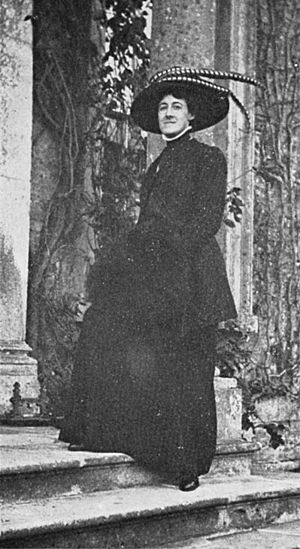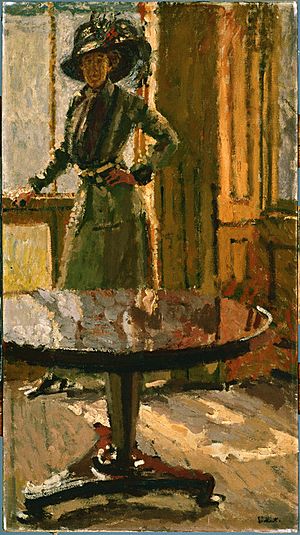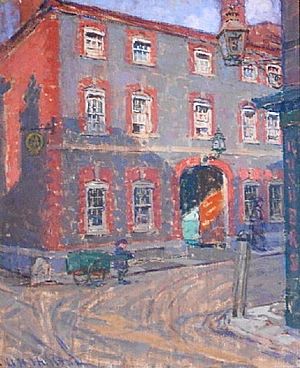Anna Hope Hudson facts for kids
Quick facts for kids
Anna Hope (Nan) Hudson
|
|
|---|---|

Anna Hope (Nan) Hudson, photograph, about 1908
|
|
| Born |
Anna Hope Hudson
September 10, 1869 New York City, US
|
| Died | September 17, 1957 (aged 88) |
| Education | Eugène Carrière, Henri Evenepoel |
| Known for | Painting |
Anna Hope Hudson, often called Nan Hudson, was an artist born in America. She lived and worked in both France and England from 1869 to 1957. Nan Hudson helped start a famous art group called the London Group. She was also a very close friend and companion to another artist, Ethel Sands.
Contents
Early Life and Learning
Nan Hudson was born in New York City on September 10, 1869. Her mother passed away when Nan was nine years old. Her father, Colonel Edward McKenny Hudson, died later in 1892.
When she was 24, Nan moved to Europe. She especially loved living in France. She received money from her grandfather's successful business. He was a partner in a company that engraved banknotes.
Art Studies in Paris
In 1892, Nan Hudson began studying art in Paris. There, she met Ethel Sands, who became her close friend and fellow artist. Both Nan and Ethel had received money from their families.
They studied art together under a teacher named Eugène Carrière in 1896. Then, in January 1897, a Flemish painter named Henri Evenepoel became Nan Hudson's art instructor.
Becoming an Artist

Nan Hudson and Ethel Sands lived and painted together. They spent their time between France and England. Ethel Sands enjoyed hosting parties for artists and writers in England.
Nan Hudson preferred a quieter life in France. It was there that she first became known as an artist.
Exhibitions and Groups
After a trip to Venice, Nan painted the Giudecca Canal. This painting was shown in Paris at the Salon d'Automne in 1906. Walter Sickert, another artist, was very impressed by her work. He invited her to join the Fitzroy Street Group. Ethel Sands also joined this group. They would sometimes attend meetings and send their paintings for display.
Walter Sickert painted a picture of Nan Hudson around 1910. He said she was "the radiant and dashing horsewoman of a young man's dreams." This painting showed her confident and independent personality.
In England, Nan Hudson showed her art at places like Leicester Galleries and the New English Art Club. In 1912, she had a joint art show with Ethel Sands.
In 1913, the Fitzroy Street Group and another group joined together. They formed the London Group. Both Nan Hudson and Ethel Sands were founding members of this new group. Nan continued to show her art there until 1938. She also kept exhibiting her work at the English Art Club. Sometimes, Walter Sickert invited Nan to work in his studios. She used his models for her paintings.
Many of Nan Hudson's artworks were lost or destroyed during World War II. However, some of her paintings are still in public collections today. One of her works is at the Tate museum.
During the World Wars
During World War I, Nan Hudson and Ethel Sands helped soldiers. They set up a hospital near Dieppe in France. When it had to close, they continued their nursing work in both France and England.
In World War II, Nan Hudson's house was damaged and robbed. Ethel Sands' home in Chelsea, England, was destroyed during The Blitz.
Later Life and Works
In 1920, Nan Hudson bought a beautiful old house from the 1600s. It was called the Château d’Auppegard. This house was in the countryside, about 10 miles from Dieppe. She spent time restoring and decorating her beloved home.
Nan Hudson and Ethel Sands lived together until Nan passed away on September 17, 1957.
Surviving Artworks
Here are some of Nan Hudson's paintings that survived the wars:
- Château d’Auppegard, painted after 1927. This oil painting is at the Tate museum.
- Harbour, Northern France, Dieppe, an oil painting in the Government Art Collection.
- Newington House, Autumn, Oxfordshire, painted in 1913. This oil painting is at the Derby Museums and Art Gallery.
- The Lamb Inn, Wallingford, painted in 1912.
- The Visitor, an oil painting at the York Museums Trust.
See also
 In Spanish: Anna Hope Hudson para niños
In Spanish: Anna Hope Hudson para niños


